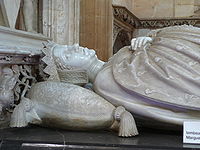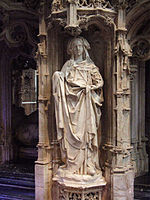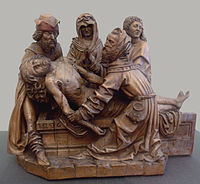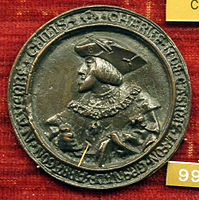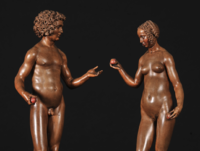Conrad Meit

Conrad Meit or (usual in German) Conrat Meit (1480s in Worms; 1550/1551 in Antwerp) was a German-born Late Gothic and Renaissance sculptor, who spent most of his career in the Low Countries.[1]
The royal tombs that were his largest works still had elaborate Late Gothic architectural frameworks by others, but Meit's figures were Renaissance in conception and style. Meit's work, with its delicately worked plasticity and pronounced corporality, brought an entirely new form of expression to Late Gothic church sculpture. The anatomy of his nude figures draws more from Albrecht Dürer than from classical sculpture.[2]
Later many of his works in Brussels, Antwerp, Tongerlo Abbey, and elsewhere were destroyed in the Reformation and French Revolution, leaving the three royal monuments at the then newly built Royal Monastery of Brou, Bourg-en-Bresse, as his outstanding surviving large works.[3] A number of small works, including portrait busts in wood, and small statuettes in various materials have survived.[4] The documented tombs and the signed alabaster statuette of Judith (illustrated below) are the main secure works for defining his style.[5]
Life and works
Meit's date of birth at Worms on the
Tomb group at Brou
For Margaret of Austria Meit made his most famous works, the figures on the group of three monumental royal tombs for Margaret, her husband
Philibert had died at the age of 24 in 1504, so Meit's images of him are based on other portraits, and rather idealized.[11] His majestic grave monument is placed in the middle of the Abbey's choir, with the two female tombs set against the wall on either side of it. The three aligned figures are turned towards each other, as though in communication. Though to the side, Margaret's tomb is the largest.[12]
Philibert's tomb consists of two levels and two effigies, one above the other. The upper part, in expensive imported white Carrara marble, represents the Duke in ceremonial costume, surrounded by Italian-style angels (putti). Below this ten small female figures, called the sibyls, point towards the lower effigy, which shows him naked except for a cloth over his genitals. The putti used to be turned to face the effigy, but in a modern restoration several were turned to face outwards.[13]
Margaret of Austria's tomb also has an upper effigy in marble and a lower one in alabaster. In the upper one she is shown as an older woman (she died at 50) in full state dress, wearing the crown-like
To the north, the tomb of Margaret of Bourbon consists of a single effigy placed within an enfeu and lying upon a piece of black marble, with pleurants beneath, a traditional Burgundian feature. The princess is dressed in an ermine cloak and her feet rest on a greyhound, symbol of loyalty. Behind the effigy, putti bear escutcheons with the initials of Margaret and her husband.[15]
-
Margaret of Austria's tomb
-
Margaret of Austria, upper effigy
-
Margaret of Austria, lower effigy
-
Top level of Philibert's tomb
-
Philibert's upper effigy
-
Putti around Philibert's tomb
-
One of the Sibyl figures on the base of Philibert's tomb
-
Margaret of Bourbon's effigy
Other large works
When the young

He also carved a Pietà, now in Besançon Cathedral, at the request of Margaret of Austria's chaplain, the Abbot Antoine de Montécut. The abbey of Saint Vincent de Besançon received it from the Abbot and displayed it in a small chapel dedicated to Our Lady of Sorrows.[19] Among his other works are two sculptures of Mary holding the baby Jesus, one at the Cathedral of St. Michael and St. Gudula in Brussels,[20] and the other at the Benedictine Abbey in Saint-Amand-les-Eaux.
Portraits and statuettes
From surviving letters, Margaret had initially sought out Meit for his reputation as a portraitist, and he produced a range of portraits of her and her many relations.[21] A terracotta bust of her nephew Charles V is now kept at the Gruuthuse Museum, Bruges.[22] He produced a great quantity of small sculptures in bronze and boxwood, with some of the nudes, such as Adam and Eve (there are a number of pairs) and Judith with the Head of Holophernes, often similar in style to the paintings of Cranach.[23] A striking wood Lucretia in the Metropolitan Museum of Art, New York, is in a more expressive style.[24] There is also an early Falconer in Vienna, and a wood Entombment in Munich. Together, these works look forward to later small-scale sculpture in the German Renaissance.[25]
Meit's portraits of Margaret varied between those showing her at the age when her husband was still alive, before Meit knew her, and those showing her at her age when they were made, and also reflect her different roles as Regent, archduchess, widow and family member. Some remain in the main
-
Wood Entombment in Munich, dated 1496
-
Margaret of Austria in painted wood, Vienna
-
Margaret of Austria, c. 1518, Munich
-
Emperor Charles V, about 1520
-
Eve, inboxwood, c. 1530, Vienna
-
Adam and Eve, c. 1510-1517, inboxwood
Fame
Meit placed his own portrait bust in the library of Margaret of Austria at Malines, which can be seen as a significant step in the development of the status of the artist.[30] Meit's work was valued by both Albrecht Dürer, who met him in the Netherlands in 1520–21, and may also have known him from Germany,[31] and Lucas Cranach the Elder. Dürer referred to him as the ...gute[…] bildtschniczer mit nahmen Conrad, desgleichen ich kein gesehen hab, der dienet des kaisers tochter, frau Margareth (the good sculptor named Conrad, the like of which I have not seen, who served the Emperor's daughter, lady Margaret). His reputation as an important sculptor stretched across the whole of northern Europe in the early Renaissance, but after his death both he and his sitters were lost to memory, unidentified by inscriptions on the works, and one figure was recorded in the 17th century as by Dürer, of an unidentified figure.[32]
It did not help that many works were lost, and that he memorialized the last of the Chalons Princes of Orange in the Brou tombs, and that these soon became sited in French territory, ruled by kings with no family interest in those buried there. Interest in his work revived in the late 20th century, especially in his statuettes, where "sculpture exists for its own sake in a manner unprecedented in the north, with no relation to or support by architecture".[33]
Notes
- ^ Belkin gives his dates as "(1480s?–1550/1)"
- ^ Woods
- ^ Woods; Burk
- ^ Woods; Burk
- ^ Fusco, 18
- ^ Belkin; Woods
- ^ Burk, 5; Woods
- ^ Burk, 5–6
- ^ Burk, 11
- ^ Woods
- ^ Burk, 21
- ^ Burk, 11–18
- ^ Burk, 11–18
- ^ Cohen, Chapter V; Burk, 11–18
- ^ Burk, 11–18; Woods
- ^ Burk, 4
- ^ Woods
- ^ Burk, 5; Woods
- ^ Woods
- ^ Burk, 5
- ^ Burk, 7–11
- ^ Meit's portrait of Charles V
- ^ Ceysson, Bernard (1996) p.116
- ^ Lucretia; Metropolitan Museum of Art, New York
- ^ Mueller, 187
- ^ Burk, 6–11
- ^ Burk, 7–9; Thornton, 196-203
- ^ Fusco, 18; Burk, 11
- ^ Woods
- ^ Mueller, 169
- ^ Woods
- ^ Burk, 21
- ^ Belkin
References
- Belkin, Kristin. "Meit, Conrad." The Oxford Companion to Western Art. Ed. Hugh Brigstocke. Oxford Art Online. Oxford University Press. Web. 21 Apr. 2015. subscription required
- Burk, Jens Ludwig, "Conrat Meit, Margaret of Austria's Court Sculptor in Malines and Brou", PDF version, Centre des monuments nationaux (France)
- Bernard Ceysson. La Escultura:La tradición de la escultura antigua desde el siglo XV al XVIII. Barcelona, Carroggio, 1996. ISBN 84-7254-245-9.
- Cohen, Kathleen, Metamorphosis of a Death Symbol: The Transi Tomb in the Late Middle Ages and the Renaissance, 1973, University of California Press, ISBN 0520018443, 9780520018440, google books
- Fusco, Peter, et al., Masterpieces of the J. Paul Getty Museum: European Sculpture, 1997, Getty Publications, ISBN 0892365137, 9780892365135, google books
- Mueller, Theodor, Sculpture in the Netherlands, Germany, France, Spain: 1400–1500, 1966, (Pelican History of Art) Penguin Books
- Thornton, Dora, A Rothschild Renaissance: The Waddesdon Bequest, 2015, British Museum, ISBN 9780714123455
- Woods, Kim W., "Meit, Conrat." Grove Art Online. Oxford Art Online. Oxford University Press. Web. 21 Apr. 2015. subscription required
Further reading
- Jacques Baudoin, La sculpture flamboyante en Bourgogne et Franche-Comté, éd. de Borée, 1993
- Renate Eikelmann (ed.): Conrat Meit. Bildhauer der Renaissance – „desgleichen ich kein gesehen …“ Hirmer, München 2006, ISBN 978-3-7774-3385-1
- Constance Lowenthal: Conrat Meit. Ann Arbor (Michigan) Univ. Microfilms International, 1981; Originally: New York University PhD Dissertation. 1976
- von der Osten, G., and Vey, H., Painting and Sculpture in Germany and the Netherlands (1969)
- Marie-Anne Sarda et Magali Philippe, Le Monastère royal de Brou, Bourg-en-Bresse, Fondation BNP Paribas, 2005, p. 34
- Georg Tröscher: Conrat Meit von Worms. Ein rheinischer Bildhauer der Renaissance. Urban, Freiburg im Breisgau 1927
- Exposition: Vivre et mourir à la Renaissance, la destinée européenne de Philibert de Chalon, Prince d'Orange (1502–1530) 20 September 2002 – 23 March 2003, Archaeological Museum of Lons le Saunier
External links
- Blogpost with good pictures
- Commemorative Exhibition, Conrat Meit Bildhauer der Renaissance at the Bavarian National Museum (in German, on Internet Archive)
- Conrad Meit's boxwood sculptures


